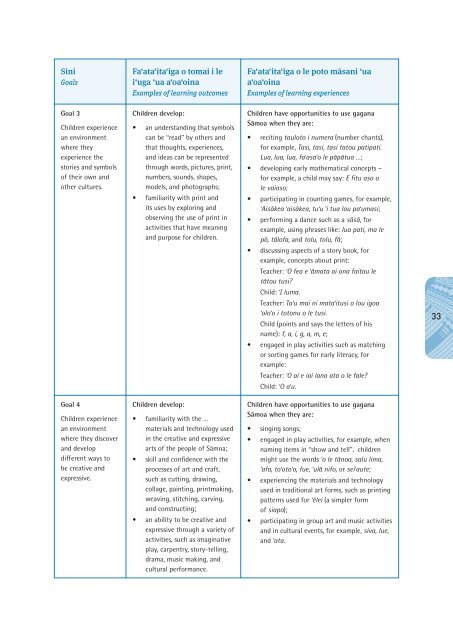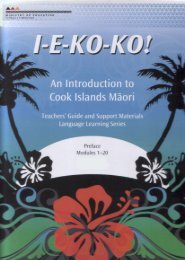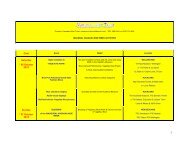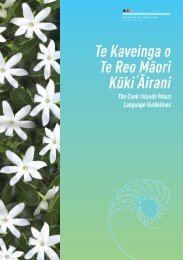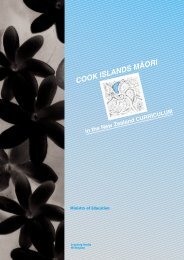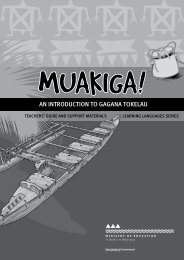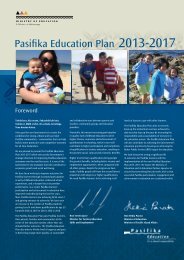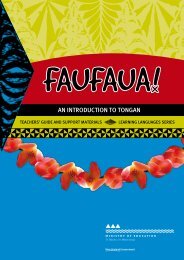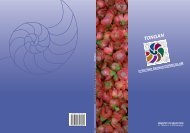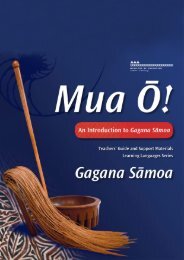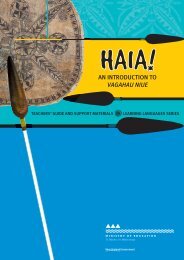Ta'iala mo le Gagana SÄmoa - Pasifika Education Community
Ta'iala mo le Gagana SÄmoa - Pasifika Education Community
Ta'iala mo le Gagana SÄmoa - Pasifika Education Community
You also want an ePaper? Increase the reach of your titles
YUMPU automatically turns print PDFs into web optimized ePapers that Google loves.
SiniGoalsFa‘ata‘ita‘iga o tomai i <strong>le</strong>i‘uga ‘ua a‘oa‘oinaExamp<strong>le</strong>s of <strong>le</strong>arning outcomesFa‘ata‘ita‘iga o <strong>le</strong> poto māsani ‘uaa‘oa‘oinaExamp<strong>le</strong>s of <strong>le</strong>arning experiencesGoal 3Children experiencean environmentwhere theyexperience thestories and symbolsof their own andother cultures.Goal 4Children experiencean environmentwhere they discoverand developdifferent ways tobe creative andexpressive.Children develop:• an understanding that symbolscan be “read” by others andthat thoughts, experiences,and ideas can be representedthrough words, pictures, print,numbers, sounds, shapes,<strong>mo</strong>dels, and photographs;• familiarity with print andits uses by exploring andobserving the use of print inactivities that have meaningand purpose for children.Children develop:• familiarity with the …materials and technology usedin the creative and expressivearts of the peop<strong>le</strong> of Sā<strong>mo</strong>a;• skill and confidence with theprocesses of art and craft,such as cutting, drawing,collage, painting, printmaking,weaving, stitching, carving,and constructing;• an ability to be creative andexpressive through a variety ofactivities, such as imaginativeplay, carpentry, story-telling,drama, music making, andcultural performance.Children have opportunities to use gaganaSā<strong>mo</strong>a when they are:• reciting tauloto i numera (number chants),for examp<strong>le</strong>, Tasi, tasi, tasi tatou patipati.Lua, lua, lua, fa‘asa‘o <strong>le</strong> pāpātua …;• developing early mathematical concepts –for examp<strong>le</strong>, a child may say: E fitu aso o<strong>le</strong> vaiaso;• participating in counting games, for examp<strong>le</strong>,‘Aisākea ‘aisākea, tu‘u ‘i tua lou pa‘umasi;• performing a dance such as a sāsā, forexamp<strong>le</strong>, using phrases like: lua pati, ma <strong>le</strong>pō, tālofa, and tolu, tolu, fā;• discussing aspects of a story book, forexamp<strong>le</strong>, concepts about print:Teacher: ‘O fea e ‘āmata ai ona faitau <strong>le</strong>tātou tusi?Child: ‘I luma.Teacher: Ta‘u mai ni mata‘itusi o lou igoa‘olo‘o i totonu o <strong>le</strong> tusi.Child (points and says the <strong>le</strong>tters of hisname): f, a, i, g, a, m, e;• engaged in play activities such as matchingor sorting games for early literacy, forexamp<strong>le</strong>:Teacher: ‘O ai e iai lana ata o <strong>le</strong> fa<strong>le</strong>?Child: ‘O a‘u.Children have opportunities to use gaganaSā<strong>mo</strong>a when they are:• singing songs;• engaged in play activities, for examp<strong>le</strong>, whennaming items in “show and tell”, childrenmight use the words ‘o <strong>le</strong> tānoa, salu lima,‘afa, to‘oto‘o, fue, ‘ulā nifo, or sei‘aute;• experiencing the materials and technologyused in traditional art forms, such as printingpatterns used for ‘ē<strong>le</strong>i (a simp<strong>le</strong>r for<strong>mo</strong>f siapo);• participating in group art and music activitiesand in cultural events, for examp<strong>le</strong>, siva, lue,and ‘ata.33


